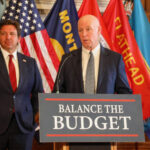Energy Secretary Declares ‘Era of Energy Subtraction’ Over at Montana Summit
Wright calls artificial intelligence the 'next Manhattan Project' as four governors rally behind energy expansion
By Staff Writer
Oct 20, 2025
BOZEMAN — Four governors and the U.S. Energy Secretary delivered a unified message at Montana’s energy summit last Thursday: America must rapidly expand electricity production to compete globally, with artificial intelligence driving unprecedented demand that could reshape the nation’s power grid.
At the 2nd Annual Big Sky, Bright Future Economic Summit, Energy Secretary Chris Wright declared the “era of energy subtraction is over,” while governors from Montana, Wyoming, Nebraska and Puerto Rico outlined how states are leading federal energy policy under the Trump administration.
“We are not out to subtract energy sources, drive up costs and burden families,” Wright said via video from Washington, D.C. “We want to bring back common sense and unleash American energy across the board — producing record levels of oil, natural gas. We want to revitalize the coal and nuclear industries and advance next-generation technologies that secure our energy independence.”
Wright’s remarks came as Montana faces doubled electricity demand projections that jumped from 9 percent to 20 percent growth over the next decade — a surge driven largely by artificial intelligence and data center development.
AI as ‘Next Manhattan Project’
Wright characterized artificial intelligence as requiring more power than any technology in history, comparing it to the World War II Manhattan Project in national importance.
“AI is the next Manhattan Project, which requires an all-hands-on-deck national effort that will define our competitiveness for decades to come,” Wright said. “China is all in on developing artificial intelligence. We need to move more rapidly. We need to keep the United States in the lead.”
The Energy Secretary said his department recently found that demand from data centers and manufacturing reshoring is growing much faster than new electricity generation is being built.
“The answer to this is not to ration electricity, but to produce more of it,” Wright said.
‘Best-of-the-Above’ vs ‘All-of-the-Above’
Wyoming Governor Mark Gordon offered a nuanced take on energy strategy that differed slightly from the traditional “all-of-the-above” approach, suggesting states should focus on their most effective energy sources.
“When we say all-of-the-above, we really mean best-of-the-above,” Gordon said during a governors’ panel moderated by Montana Governor Greg Gianforte. “In Wyoming, we export a tremendous amount of energy. So we approach it knowing that we can’t go into the future by regulating ourselves, rather going into the future by innovating.”
Nebraska Governor Jim Pillen emphasized his state’s unique position as the only state with entirely public power. Puerto Rico Governor Jenniffer González-Colón highlighted improved federal cooperation under the Trump administration compared to previous years.
“When President Trump came in office, I was instantly able to get a meeting with him and Secretary Wright,” González-Colón said. “Since he’s been in office, the Department of Energy has sent a team eight times to the island to meet with my administration.”
Federal Policy Shifts
Wright outlined significant policy reversals from the previous administration, particularly regarding liquefied natural gas exports. He said the Trump administration has approved more than 13 billion cubic feet per day of additional export capacity in nine months — roughly equal to the entire export capacity that existed when they took office.
“When we came to power in January, there was a pause on approval of LNG export terminals, a total shame,” Wright said. “We have reversed that policy.”
The Energy Secretary also announced ambitious nuclear energy goals, targeting 300 gigawatts of new nuclear capacity by 2050 — four times current levels.
“This is a once-in-a-generation effort to restore American leadership in nuclear energy,” Wright said.
Montana’s Energy Leadership
Governor Gianforte positioned Montana as leading the multi-state energy cooperation, emphasizing improved federal agency access under the current administration.
“In Montana, we are leading on energy with our ‘all-of-the-above’ energy strategy and that was on full display at today’s Chamber summit,” Gianforte said. “With unprecedented access to the Trump administration, a stark departure from what we saw under the Biden administration, governors are leading the way to power our states, our country, and the world.”
The summit connected directly to Gianforte’s Unleashing American-Made Energy Task Force, which must deliver legislative recommendations by September 2026. Several task force members participated in the summit, creating a pipeline from federal policy discussions to potential Montana legislation.
Business leaders and policymakers at the summit discussed expanding transmission capacity, simplifying regulations, and establishing next-generation power solutions to meet Montana’s unprecedented demand growth.
Wright emphasized that energy security underpins both economic prosperity and national defense, warning against dependence on weather-dependent sources or hostile foreign suppliers.
“Around the world, we’ve seen what happens when countries depend on unreliable energy sources or a single source, a foreign supplier that may be a hostile supplier,” Wright said. “What this leads to is factories shut down, costs soar, and national sovereignty erodes.”
Categories: Energy, Government, National
Don’t miss the week’s top Montana stories
Join readers across Montana who rely on WMN for independent reporting.
Unsubscribe anytime. Want to support WMN? Upgrade for $4/month →





